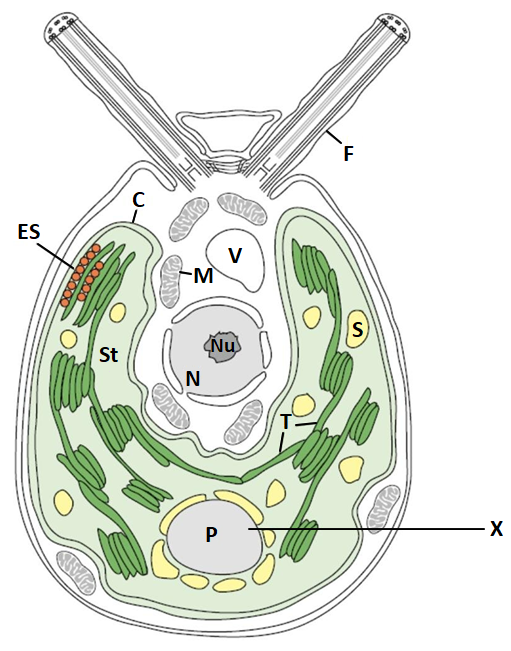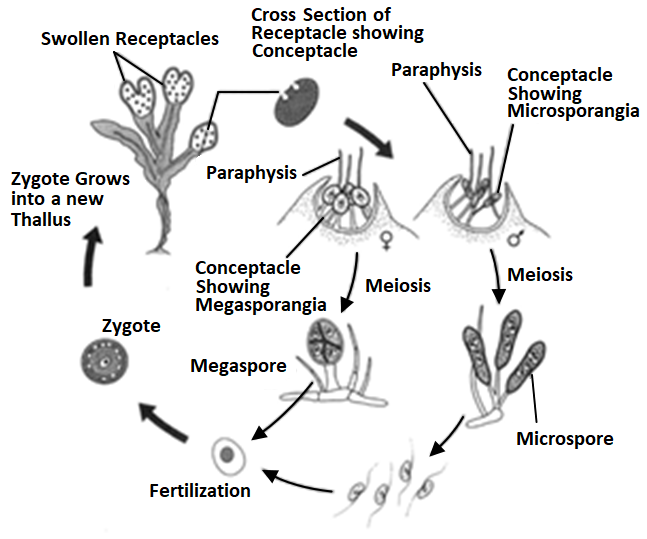In contrast to conifers, gnetophytes produce:
1.
Simple pollen strobili and simple seed strobili
2.
Simple pollen strobili and compound seed strobili
3.
Compound pollen strobili and simple seed strobili
4.
Compound pollen strobili and compound seed strobili
Rather than having true roots, stems and leaves the members of Phaeophyceae have root like holdfast, stem like stipe and leaf like fronds. What will be true for these structures?
| I. | Holdfasts are not the primary organs for water and nutrient uptake. |
| II. | In brown algae like Fucus, the tissues in stipe include a central pith, a surrounding cortex and an outer epidermis. |
| III. | Gas filled floats called pnematocysts provide buoyancy in many brown algae. |
1. I and II only
2. I and III only
3. II and III only
4. I, II and III
The term ‘seaweeds’ is used to describe several macroscopic, multicellular marine algal species belonging to:
I. Chlorophyceae
II. Phaeophyceae
III. Rhodophyceae
| 1. | I and II only | 2. | I and III only |
| 3. | II and III only | 4. | I, II and III |
What would be true for the structure labeled with letter ‘X’ in the given diagram showing the ultrastructure of Chlamydomanas?
| 1. | It is the region of the chloroplast where circular DNA is present |
| 2. | It is associated with the operation of a carbon-concentrating mechanism (CCM) |
| 3. | It is the inclusion body with accumulated toxic wastes for elimination |
| 4. | It is filled with air and is responsible for buoyancy of the organism |
The diagram shows a sorus in section in ferns. What would be the name for A?
1. Annulus
2. Placenta
3. Indusium
4. Stomium
The given pattern of life cycle will be seen in:
| 1. Spirogyra | 2. Fucus |
| 3. Ectocarpus | 4. Polysiphonia |

To unlock all the explanations of 38 chapters you need to be enrolled in MasterClass Course.

To unlock all the explanations of 38 chapters you need to be enrolled in MasterClass Course.
The given pattern of life cycle will be seen in:
| 1. Spirogyra | 2. Fucus |
| 3. Ectocarpus | 4. Polysiphonia |

To unlock all the explanations of 38 chapters you need to be enrolled in MasterClass Course.

To unlock all the explanations of 38 chapters you need to be enrolled in MasterClass Course.
The given pattern of life cycle will be seen in:
| 1. Spirogyra | 2. Fucus |
| 3. Chlamydomanas | 4. Polysiphonia |

To unlock all the explanations of 38 chapters you need to be enrolled in MasterClass Course.

To unlock all the explanations of 38 chapters you need to be enrolled in MasterClass Course.
In the given longitudinal section of archegonium of moss identify A, B, C and D respectively:
| 1. | Ventral canal cell, Neck canal cell, Egg, Venter |
| 2. | Ventral canal cell, Neck canal cell, Venter, Egg |
| 3. | Neck canal cell, Ventral canal cell, Venter, Egg |
| 4. | Neck canal cell, Ventral canal cell, Egg, Venter |
The given diagram shows the life cycle of:
1. Polysiphonia
2. Fucus
3. Laminaria
4. Ectocarpus













